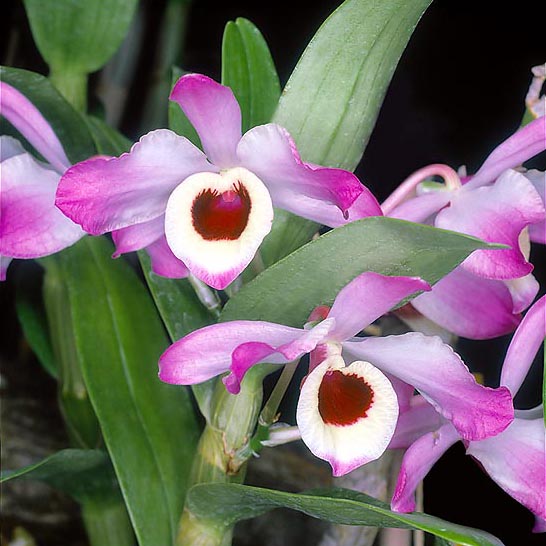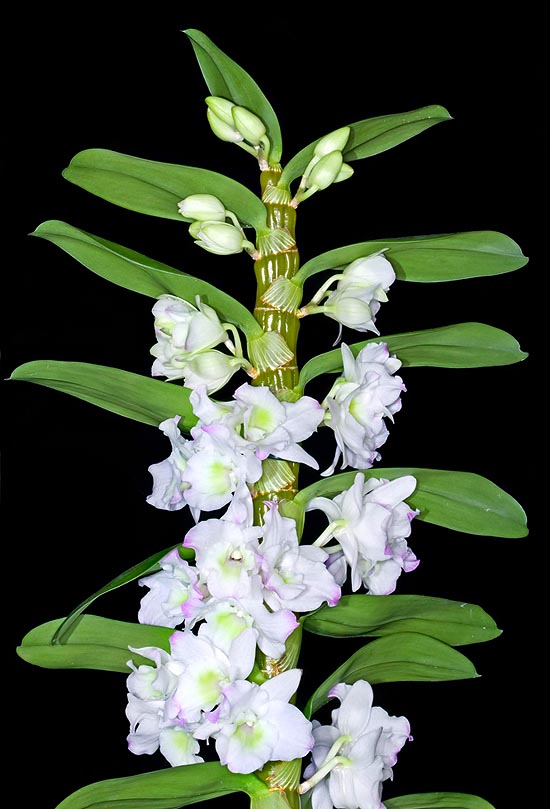Family : Orchidaceae

Text © Pietro Puccio

English translation by Mario Beltramini

Dendrobium nobile is epiphyte or lithophyte, with 20-70 cm stems and 6-8 cm flowers © Mazza
The name of the genus is the combination of the Greek terms “déndron” = tree and “bios” = life, with reference to the numerous species of the genus living on the trees; the name of the species is the Latin term “nobilis, e” = noble.
Common names: cane orchid (English); jin-chai-shi-hu (Chinese); orquídea olho-de-boneca (Portuguese-Brazil).
The Dendrobium nobile Lindl. (1830) is an epiphytic or lithophytic species with knotty, close together, stems, erect, slightly compressed and grooved, 20-70 cm long, of yellowish green colour and coriaceous leaves, persistent for two years, alternate, distichous, oblong, 6-10 cm long and 1-3 cm broad.
Inflorescences in winter-spring at the nodes of the two or more years old stems, carrying 1-4 flowers of 6-8 cm of diameter with sepals and petals usually white, more or less nuanced of purple pink at the extremity, and labellum with purple red spot at the centre, perfumed.
The sepals are oblong with pointed apex, about 3,5 cm long and 1,5 cm broad; the petals are ovate, as long as the sepals and 2-2,5 cm broad with edges slightly waved; the labellum is obovate, pubescent, 4 cm long and about 3 cm broad with the base wrapping the about 0,5 cm long column.
It reproduces by seed, in vitro, by micro-propagation, by division and by means of the young plants forming at the nodes which have not carried flowers (in jargon, “keiki”, which, in Hawaiian means “sons”), which may be removed when they have formed a good rooting apparatus; keiki may form also from the nodes of the stems placed horizontally, entire or at portions of about 15 cm, on sphagnum kept constantly humid. With its numerous hybrids and varieties it is perhaps the most popular and the most cultivated since long time among the Dendrobium due to the beauty and the nicety of its long-lasting flowers, 4-6 weeks.

Various hybrids do exist, they easily reflower also indoor © Giuseppe Mazza
In spring-summer, it requires high temperatures and humidity with frequent morning waterings, regular fertilizations till August and a slight shade, in autumn the waterings are to be reduced until to be almost stopped, avoiding, in any case, to get the stems too much wrinkled, placing the plant in a cool and quite luminous, even direct sun for some hours each day, such as a window facing south if it’s cultivated in an apartment, with a good air circulation.
When the flower buds appear, the frequency of the waterings is to be gradually increased and then same are to be resumed regularly when the new roots come out. For the waterings and the nebulisations, are to be utilized rain water, or water obtained by reverse osmosis, or demineralised; the fertilizations, duly distributed in way to avoid salts accumulations, are to be done preferably with hydro-soluble balanced products, with microelements, at half dosage, or less, of what suggested on the package.
It can be mounted on bark, trunks, rafts of cork or of roots of arborescent ferns, or cultivated in small pots with much draining and aerated compost, which can be formed by fragments of bark, of medium size, sphagnum and charcoal. Repottings, transplants and divisions are to be done by the end of the flowering.
The fresh or dried up stems, which contain several alkaloids, among which the most abundant is the dendrobine, are utilized in the traditional Chinese medicine for various pathologies; the dendrobine is also extracted industrially and exported, this has contributed to the rarefying of the species in the wild.
The species is inscribed into the appendix II of the CITES (species whose trade is internationally ruled).
Synonims: Dendrobium coerulescens Wall. ex Lindl. (1838); Dendrobium lindleyanum Griff. (1851); Callista nobilis (Lindl.) Kuntze (1891); Dendrobium formosanum (Rchb.f.) Masam. (1933).
→ For general notions about ORCHIDACEAE please click here.
